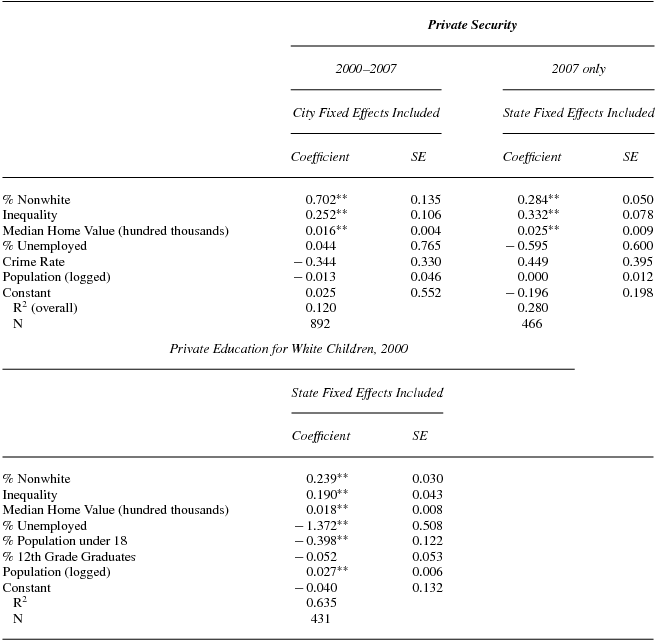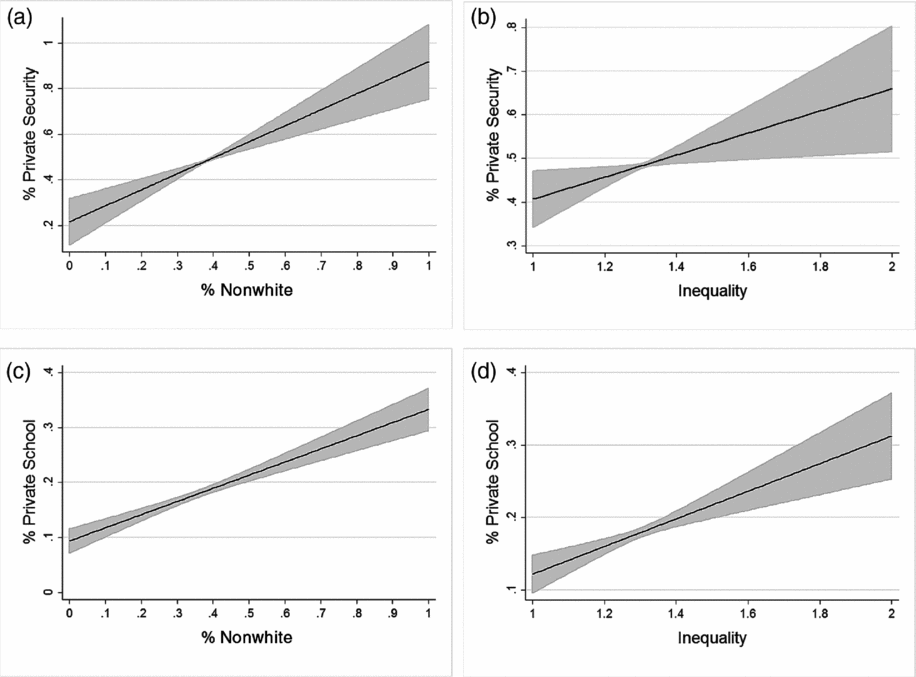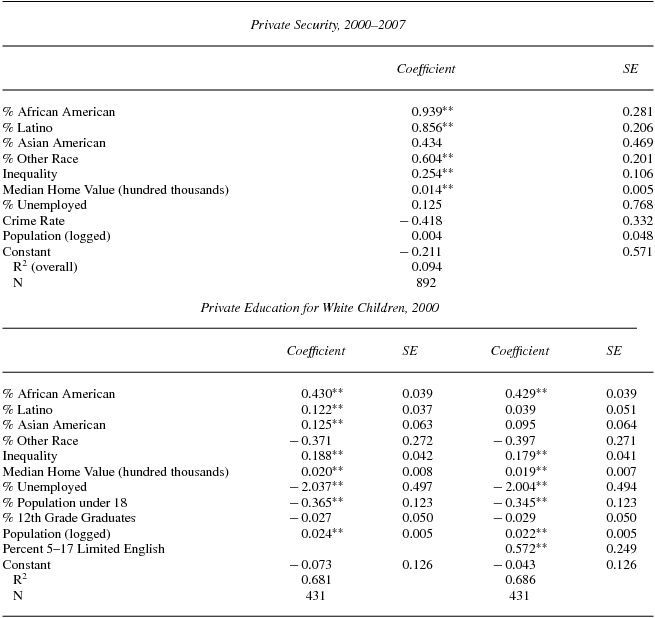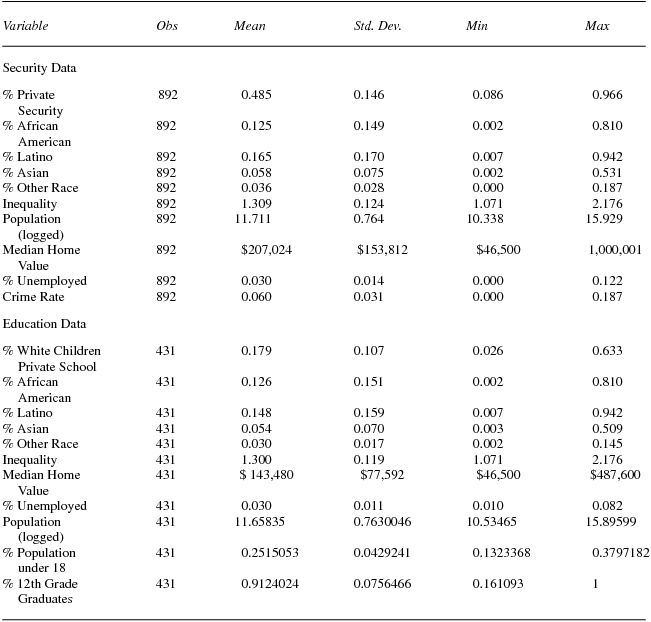In the United States the provision of many public goods is handled at local levels of government. Variation within and across cities regarding the adequacy of public goodsFootnote 1 is a consequence of local control over development, revenues, and service provision. As a result, only some residents live in safe communities with well-maintained roads, sewers that never overflow, and public parks with swing sets and restrooms. Many others live in places that suffer from low-quality schools, drainage problems, poorly equipped police and fire forces, and overcrowded municipal jails. What explains these patterns? It is unlikely that some communities want to have high crime rates and poor-quality schools. I argue that economically and racially homogenous communities are collectively willing to invest more resources in public goods relative to diverse communities. I provide evidence in support of this claim by showing that heterogeneous communities witness a greater share of public goods provided through the private market in the realms of security and education. The privatization of traditionally public goods means that absent these choices, expenditures on public services would likely be higher in diverse communities.
A number of scholars have provided significant evidence that diversity along racial and ethnic lines can dampen support for public goods (Alesina and Spolaore Reference Alesina and Spolaore1997; Alesina et al. Reference Alesina, Baqir and Easterly1999; Cutler et al. Reference Cutler, Elmendorf and Zeckhauser1993; Easterly and Levine Reference Easterly and Levine1997; Glaser Reference Glaser2002; Goldin and Katz Reference Goldin and Katz1999; Habyarimana et al. Reference Habyarimana, Humphreys, Posner and Weinstein2007, Reference Habyarimana, Humphreys, Posner and Weinstein2009; Hopkins Reference Hopkins2009; Miguel Reference Miguel2004; Poterba Reference Poterba1997; Putnam Reference Putnam2007). Diversity may depress public goods investment for a number of different (and overlapping) reasons including an inability to sanction noncontributors (Habyarimana et al. Reference Habyarimana, Humphreys, Posner and Weinstein2009), divergent preferences regarding the targets of spending (Benabou Reference Benabou1996; Lieberman and McClendon Reference Lieberman and McClendon2013), and opposition to expenditures perceived to benefit other groups (Becker Reference Becker1957; Glaser Reference Glaser2002; Sears and Citrin Reference Sears and Citrin1985; Tedin et al. Reference Tedin, Matland and Weiher2001). Conflict over spending preferences and/or an unwillingness to engage in spending on other groups means that public goods in diverse communities may be underprovided. As a result, I argue, when a private option exists, diverse communities should see a higher degree of privatization of public goods.
I provide evidence in support of this claim by analyzing the relationship between race and income diversity and the share of community security and education that is provided by private entities. Security and education concerns are central to local political debates. Homeowners are the dominant force in local politics, and their collective preferences, driven by the protection of home values, play an important role in determining the inputs and outputs of local government including taxation, zoning, and service decisions (Fischel Reference Fischel2001). Crime and school performance are capitalized in housing prices (Black Reference Black1999; Taylor Reference Taylor1995) and, as a result, play a large role in local contestation. Additionally both education and crime are generally racialized issue areas, particularly for whites (Bobo Reference Bobo1983; Hurwitz and Pefley Reference Hurwitz and Peffley1997, 2005; Mendelberg Reference Mendelberg2001; Tuch and Hughes Reference Tuch and Hughes1996). This means that white, home-owning residents are especially likely to be sensitive to diversity with respect to these issue areas. I find that as racial diversity and income inequality increase, the share of private security guards and white children enrolled in private school is higher. In the remainder of the article, I review the relevant literature, describe the data used for my analysis, present the empirical results, and offer a concluding discussion.
Relevant Literature
In a variety of different settings, scholars have shown that diversity (particularly along ethnic lines) can be associated with policy conflict (Powell Reference Powell1982), slow economic growth (Alesina et al. Reference Alesina, Devleeschauwer, Easterly, Kurlat and Wacziarg2003; Easterly and Levine Reference Easterly and Levine1997), poor public policies (Montalvo and Reynal-Querol Reference Montalvo and Reynal-Querol2005; Posner Reference Posner2004), and reduced investment in public goods (Alesina et al. Reference Alesina, Baqir and Easterly1999; Hopkins Reference Hopkins2009; Poterba Reference Poterba1997; Vigdor Reference Vigdor2004). Additionally, a large literature on public opinion and political behavior reveals that negative perceptions of racial and ethnic minorities and the poor and are strongly predictive of their views toward government spending (Applebaum Reference Applebaum2001; Federico Reference Federico2005; Federico and Luks Reference Federico and Luks2005; Gilens Reference Gilens2009; Luttmer Reference Luttmer2001; Sears and Citrin Reference Sears and Citrin1985). However, other scholars have provided evidence that diverse and unequal cities spend as much money or even more on many public services including policing, fire protection, health, hospitals, and education (Boustan et al. Reference Boustan, Ferreira, Winkler and Zolt2012; Corcoran and Evans Reference Corcoran and Evans2010; Glennerster et al. Reference Glennerster, Miguel and Rothenberg2013). Research in this tradition has provided evidence that public policies (Miguel Reference Miguel2004) and strategic politicians (Rugh and Trounstine Reference Rugh and Trounstine2011) can overcome the depressive effects of diversity on public spending. However, higher expenditures may not correspond to equivalent quality of public goods. One of the problems scholars face in this literature is determining what the ideal amount of spending would be for any given community. Simply analyzing total dollars (or even proportions of budgets) spent on different categories may not give us an accurate picture of the degree to which the community's demands for public goods are being met. I take an alternative approach by setting aside public spending and focusing on services for which a private option exists.
If diverse communities struggle to provide adequate levels of public goods, then, regardless of the amount of money that is spent, we ought to expect some residents to be unhappy with the provision. Dowding and John (Reference Dowding and John2008) argue that private options are more likely to be adopted when residents, dissatisfied with public provision, have been unable to affect change in the public realm. Brooks (Reference Brooks2008) shows that business improvement districts (which might be considered a strategy somewhere between fully public and fully private provision) allow a subset of voters to increase investment in public goods when they are dissatisfied with public policy. The problem is cyclical; some residents in diverse communities shift resources from public goods to private alternatives, leading to suboptimal public goods provision, which may then lead other residents to select the private option. As a result, when private options exist, we should expect to see a higher rate of privatization in diverse communities. Security and education are two services that can be met in either the public or the private realm.
My predictions build on a literature investigating the relationship between diversity and private provision of public goods in the realm of education. Conlon and Kimenyi (Reference Conlon and Kimenyi1991) and Fairlie and Resch (Reference Fairlie and Resch2002) analyze individual-level data and provide evidence that private school enrollments are higher when public schools have large proportions of nonwhite (particularly black) students. Similarly, Betts and Fairlie (Reference Betts and Fairlie2003) show that in response to increased immigration, native-born American families are more likely to send their children to private high school. Smith and Meier (Reference Smith and Meier1995) and Wrinkle et al. (Reference Wrinkle, Stewart and Polinard1999) find that a desire for religious instruction and racially segregated schools motivates private enrollment in Florida and Texas. These findings lay the foundation for my argument that an increase in diversity will increase private provision of public goods relative to public provision.Footnote 2 The results presented in this article build on these earlier findings by expanding the analysis to the entire United States, providing evidence of an aggregate effect, and incorporating findings on education into a larger theory of private provision.
An important alternative argument is that poor governmental performance generates the impetus for privatization and vice versa (poor private provision leads to public funding). A number of scholars argue that failures of the private market led to the development of municipal public goods provision such as policing (Dart Reference Dart1981; Enion Reference Enion2009), schooling (Goldin and Katz Reference Goldin and Katz1999), and water supply (Cutler and Miller Reference Cutler and Miller2005). For example, Kaufman (Reference Kaufman1999) provides a historical analysis revealing that public police forces were frequently adopted by city councils when weak property rights limited the city's ability to promote urban development and economic growth. Predicting the opposite effect, Berman (Reference Berman2005) develops a formal model of voluntary provision of public goods using religious organizations. He finds that in the absence of government provision of public goods, individuals will naturally band together to provide public goods “through mutual insurance,” like clans, sects, and tribes (ibid.: 2). Similarly, Enion (Reference Enion2009) argues that private security forces arose in the nineteenth century acting on behalf of corporations and slave owners to exact punishment and control that the state was unwilling to provide directly. Dart (Reference Dart1981) suggests that private security forces expanded in the wake of severe, exogenous constraints on local fund-raising ability (e.g., Proposition 13). Chubb and Moe (Reference Chubb and Moe1990) argue that private schooling is a response to the failures of the public education system. For the purposes of this analysis, it could be the case that limited government expenditures on policing or high crime rates could increase the prevalence of private security and poor performance of public schools increase private school enrollments.Footnote 3 In order to account for this alternative, I control for measures of performance in my analysis in the following text.
Data
In order to analyze the relationship between diversity and inequality and private provision of public goods, I assembled a data set drawing on a variety of different government data sources. First, I collected data from the 2000 Census of Population and Housing and the 2005–2007 American Community Survey (ACS) regarding the occupational breakdown of the population in all US incorporated places (e.g., cities, towns, and villages) with more than 20,000 residents.Footnote 4 I focused on the broad category entitled “protective service.” Each year the US Census reports the total number of residents employed as “fire fighting, prevention, and law enforcement workers including supervisors” and “other protective service workers including supervisors” (US Census Bureau 2005–2007: table B24010). The former comprises my measure of public security officers and the latter my measure of private security officers.Footnote 5 A list of occupations included in each category can be found in the appendix. This process yielded a count of the number of individuals employed in private and public security jobs in each city at two points in time. I have complete data for 446 cities.
To study privatization of education I gathered the total number of children enrolled in kindergarten through twelfth grade in public and private school from the Census of Population and Housing. I focus on the enrollment of white, non-Hispanic/Latino children because I expect sensitivity to diversity to be driven by the white community. Unfortunately, the census only makes enrollment by race available in one year—2000, so the analysis is limited to a single point in time. This analysis includes the same cases as included in the security analysis.Footnote 6
To the occupation and school enrollment data I merged community demographic data from the 2000 Census of Population and Housing and the ACS including information on the racial makeup of the city, the income distribution, and a variety of demographic control variables that are described in the following text. I collected data from the Federal Bureau of Investigation's Uniform Crime Reporting Program regarding the total number of crimes reported to police in 2000 and 2007 and data from the National Center on Education Statistics regarding the proportion of twelfth graders completing high school in the 1999–2000 school year at the county level. Summary statistics are included in the appendix.
Analysis
The dependent variable in my analysis of community security is a measure of the proportion of total security officers who are employed by private entities (percent private security) in 2000 and 2007. The denominator of this variable is the sum of private and public security officers in the city. My two main independent variables are measures of diversity and inequality. For the former, I use the proportion of the population that identifies as nonwhite (including Latino, black, Asian/Pacific Islander, and other).Footnote 7 To measure inequality I use the ratio of mean to the median income in the city.Footnote 8 The ratio of mean to median income ranges from 1.1 to 2.2. A value of 1 indicates that the median and mean incomes are equal and a value of 2 indicates that the mean income is twice that of the median.
To account for the possibility that communities turn to privatization because of government failures I include the city's crime rate. To capture the prospect that cities with poor employment markets have a lower share of private security officers, I include the proportion of the population that is unemployed. To account for the ability of community members to afford public and private security, I include the city's median home value. Finally, I control for the natural log of total population.Footnote 9 Because I have measures of diversity and the share of security that is privately provided at two points in time, I add fixed effects for city. This means that the model accounts for all static city-level variables that could predict preferences for private security. In order to provide evidence of a cross-sectional effect as well, I also show the results of a regression using only the 2007 data with state fixed effects included.
In the analysis of privatization of education my dependent variable is the proportion of white children attending school between kindergarten and twelfth grade enrolled in private school (percent private school). As in the security model my primary independent variables are measures of the nonwhite population and inequality. I control for median home value, percent unemployed, the natural log of the total population, and racial and income segregation. I also add a measure of the proportion of the population that is under 18 to account for the correlation between age, race, and income and the possibility that families with young children are attracted to places that invest in education. Finally, as a measure of the quality of public education, I include the county-level high school graduation rate for all public schools.Footnote 10 As explained in the preceding text the dependent variable in this model is only available for a single year, so adding fixed effects for city is not possible. Instead, the model includes state fixed effects.
The top panel of table 1 shows the regression of private security on diversity and the bottom panel shows the regression of private education.
TABLE 1. Effect of diversity and inequality on private provision of public goods

*p < .10. **p < .05.
The results are clear—when cities have larger minority populations and a more skewed income distribution, the share of total security handled by private entities is larger and the proportion of white children attending private school is higher. The results are shown graphically in figures 1a–d.

FIGURE 1. Effect of diversity and inequality on private provision of public goods
Cities that gained racial and ethnic minority residents relative to whites between 2000 and 2007 saw growth in private security guards relative to police officers. For example, during this time period a city in which nonwhite residents increased from 10 percent of the population to 15 percent of the population would have seen about a 3.5 percent increase in private security (from 28.7 percent to 32.2 percent). When cities are about 40 percent minority, a majority of security forces become privatized. The same patterns occur as cities become more unequal (as they generally did over this time period). A change in the ratio of mean to median income from 1.25 to 1.30 (the average for the data set) was associated with about a 1.3 percentage point increase in private security, from 47 percent to 48.3 percent. Once the mean income is 1.3 times the median income in a community, a majority of security officers work in the private realm. An analysis of change in the number of security guards and police officers per capita reveals change in both measures. That is, between 2000 and 2007, on average cities gained security guards and lost police officers.
The results are similar for private schooling. In a city that is 95 percent white, approximately 10.6 percent of white children attend private school. With all other demographics equal, in a city that is comprised of 20 percent racial and ethnic minorities, the share of white children attending private school rises to more than 14 percent. When whites comprise only 10 percent of the population, one in every three white children attend private school. Similarly, in a city where the mean and median income are identical, about 12 percent of white children attend private school, but when the mean income is double the median, more than 30 percent of white children attend private school.
In table 2, I replace the measure of percent nonwhite with measures of the size of each nonwhite group for both private security and education. Scholars have shown that white attitudes toward Latinos and Asians tend to be less hostile and more variable relative to attitudes toward blacks (Dixon Reference Dixon2006; Hood and Morris Reference Hood and Irwin1997). As a result, privatization may be more related to some groups than others.
TABLE 2. Effect of diversity and inequality on private provision of public goods, separate racial measures

Note: City fixed effects included in security model and state fixed effects included in education model.
*p < .10. **p < .05.
Table 2 indicates some support for this prediction. The size of the black and Latino populations are positively related to security privatization, but Asian American residents do not engender the same type of response. White children are most likely to attend private school in communities with large black populations, but the size of Latino and Asian populations also appear to increase privatization. Adding a control for the language ability of the youth population (the proportion of people aged 5 through 17 with limited English proficiency) reveals that the aversion to Latino and Asian populations is largely driven by an avoidance of children who do not speak English. Collectively these results reveal that as minority populations increase, and as inequality rises, private guards make up a larger share of total security forces and a larger percentage of white children attend private school.
It is important to note that across all of the models, the measures of government performance (crime rates and high school graduation rates) do not meet conventional levels of statistical significance. This suggests that sending children to private school and hiring private security guards has little to do with objective conditions. In alternate tests I find that adding controls for the proportion of the city budget spent on policing and education are also insignificant. These findings are consistent with results in the existing literature. For example, Smith and Meier (Reference Smith and Meier1995) and Wrinkle et al. (Reference Wrinkle, Stewart and Polinard1999) find that public school performance is either unrelated or positively related to private school enrollment. This lends further credence to the argument that it is diversity in and of itself, rather than government inefficiencies or failings, that leads to privatization.
Of course, it is possible that minority residents move to cities with more private security positions available and places with more white children enrolled in private school. If this were the case, the causal story would be reversed; privatization would be driving demographic changes—not the other way around. While I believe this to be an unlikely explanation for the results presented in the preceding text, these data cannot rule out this possibility without an exogenous change to racial and income diversity. Nor can they reveal who is hiring the private security forces. If minority and poor residents hire most of the private security guards, then we would also expect to see a positive relationship between the minority population and the share of security that is privately employed.Footnote 11 Again, this seems an unlikely explanation for the patterns displayed, but additional data would be needed to test this hypothesis.
Conclusion
In sum, the data presented offer solid evidence in support of my argument. As the demographic and economic makeup of cities varies, so does the share of security personnel employed by private entities and the share of white children attending private school. When cities have more diversity and more inequality, a larger proportion of their security and education needs are met by the private sector. It appears that residents with resources choose to enhance their bundle of public goods by supplementing provision with private options when they are faced with diversity.
As Clarissa Hayward (Reference Hayward and Dilworth2009) explains, “The privileged can—and they often do—retreat to relatively homogenous [communities]. . . . They can pool their tax monies, and they can use these to provide schooling and other public services, which they can make available to residents only” (149). As a result, those with power and wealth make decisions that profoundly affect residents without access to similar resources while preventing the resource poor from participating in the decision-making process. These results challenge the conclusions drawn in recent research showing that diverse communities (with respect to both income and race/ethnicity) do not see lower expenditures on public goods in the aggregate. Boustan et al. (Reference Boustan, Ferreira, Winkler and Zolt2012) provide evidence that rising inequality and increased racial/ethnic fractionalization lead to higher government expenditures on a range of outcomes including policing and education (see also Corcoran and Evans Reference Corcoran and Evans2010; Hopkins Reference Hopkins2011). These scholars argue that their findings offer support for median voter models (Meltzer and Richard Reference Meltzer and Richard1981; Romer Reference Romer1975) that predict increased government spending in the face of rising inequality because the cost of public goods is subsidized for individuals with incomes below the community mean. It may well be the case that diverse communities see larger expenditures on public goods; but the substitution of private options for public spending indicates that public budgets would be even larger without these alternatives. This may result in increasing stratification over time as a disadvantage in access to safe communities and quality schools may compound disadvantages in other domains. Thus, residential and political patterns built on past predispositions and stereotypes may continue to shape future interests, actions, and ultimately inequalities.
Appendix
Census Occupation Coding Protective Service
Public
370: First-Line Supervisors/Managers of Correctional Officers
371: First-Line Supervisors/Managers of Police and Detectives
372: First-Line Supervisors/Managers of Firefighting and Prevention
Workers
374: Firefighters
375: Fire Inspectors
380: Bailiffs, Correctional Officers, and Jailers
382: Detectives and Criminal Investigators
383: Fish and Game Wardens
384: Parking Enforcement Workers
385: Police and Sheriff's Patrol Officers
386: Transit and Railroad Police
Private
373: Supervisors, Protective Service Workers, All Other
390: Animal Control Workers
391: Private Detectives and Investigators
392: Security Guards and Gaming Surveillance Officers
394: Crossing Guards
395: Lifeguards and Other Protective Service Workers
Summary Statistics






